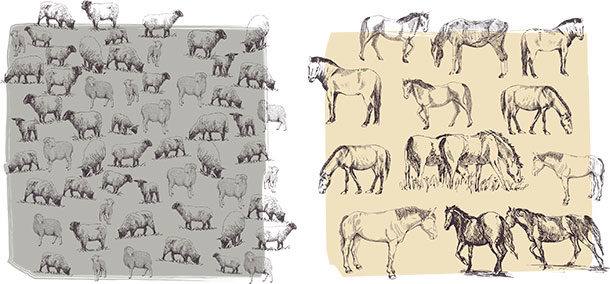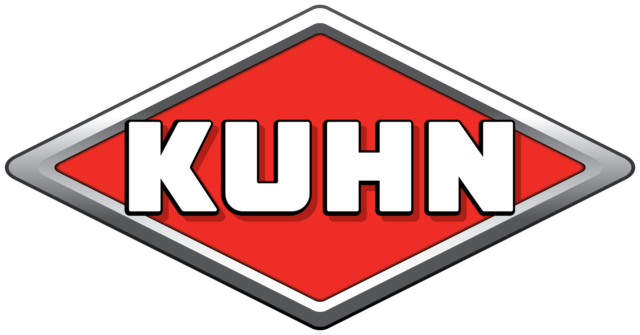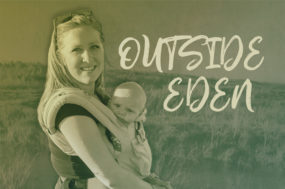This might be a good time to reflect about one of the most useful tools in our grazier’s toolbox: stocking density. As we discuss various aspects of it, you might think back to your own operation, relating how these concepts played out this year on your place and how they might apply in the future.
What is this term, stocking density (SD)? Actually, it’s really quite simple. SD is the number of pounds of animal biomass per acre. That’s it. Just add up the pounds of animals in the herd, flock, pod or whatever – regardless of species – and divide by the number of acres in the paddock. Here’s an example: If I have 23 adult cows and their calves on 4 acres (at one calf per cow), and the cows and calves average 1,200 and 400 pounds, respectively, then my SD is 9,200 pounds per acre (= 1,200 x 23 plus 400 x 23 all divided by 4).
Because SD is just a weight of grazing animals per area, independent of species, we can generate 9,200 pounds per acre on our 4 acres in many other ways: 460 lambs, each weighing 80 pounds, or 28 horses that average 1,314 pounds, or 283 goats that average 130 pounds. For that matter, four African elephants that average 9,200 pounds. Numerically, these are all the same.
In essence, SD is really an arithmetic snapshot of how much animal mass is on a pasture at a specific point in time. I can increase SD by simply confining the animals in a smaller area – by moving the electric fence. Let’s take the animals from the previous paragraph: Confining those animals in 2 acres results in an SD of 18,400 pounds per acre. Confining them in 1 acre increases the SD to 36,800 pounds per acre. (We’ll ignore the practical problems of trying to confine four elephants in 1 acre.)
I must mention an important distinction: SD is not the same as “stocking rate.” Stocking rate means the number of animals per acre over a period of time, based on a standard animal unit of a 1,000-pound cow with a calf by her side. Stocking rate is not a snapshot; it’s more like a broad description of the number of animals the land can support over time. We should think of these two concepts separately: SD as grazing pressure, stocking rate as carrying capacity.
In practice, stocking rate is primarily a tool in dry range country, where the number of livestock in an area is one of the few things ranchers can manipulate to manage their forage. But improved pastures are a very different universe than range country. Graziers managing improved pastures can easily manipulate a vast array of things to alter the amount of feed in those pastures – like reseeding the forages or adding fertilizer and lime. SD is a precise and flexible number, ideal for understanding and managing improved pastures.
So how can we use this SD concept? The most obvious way is to calculate the numerical grazing pressure on fields of different sizes. Let’s say the four fields on my farm are 5, 12, 19 and 32 acres, and my flock consists of 500 ewes averaging 150 pounds, which gives a total biomass of 75,000 pounds. Grazing this flock on the 5-acre field generates an SD of 15,000 pounds per acre (= 75,000 ÷ 5). When I move this flock to the other three fields, I reduce the SD values to 6,250, 3,947 and 2,344 pounds per acre, respectively.
 Getty Images.
Getty Images.
Let’s study these numbers. It’s clear the grazing pressure on the 5-acre field is more than six times the grazing pressure on the 32-acre field. In your opinion, which field would have more problems with weed encroachment? Which field would have a more homogenous distribution of manure? Which field would show a more uniform amount of residual forage?
The SD concept works just as well with small flocks and herds. For example, if I own a flock of 25 ewes averaging 150 pounds, my total biomass is 3,750 pounds. That doesn’t sound like much, and fencing these ewes on 1 acre results in an SD of only 3,750 pounds per acre. But when I move the electric netting to confine the ewes in only a half-acre, then I’ve doubled the SD to 7,500. And if I halve that acreage again to a quarter-acre (a square of 104 feet on each side), my SD then becomes 15,000 pounds per acre, and that has the same effect on forages as 500 of these ewes on 5 acres. (With small operations, it’s also useful to remember that 1 acre equals 43,560 square feet.)
But will animals get enough to eat at a high SD? Of course they will … if we move them off the pasture at an appropriate time. Let’s figure this out. If our pre-graze pasture contains a total mass of 3,300 pounds per acre, and we target a residual mass after grazing of 1,000 pounds, then each acre contains 2,300 pounds of feed (also called available mass). Let’s say we aim for an SD of 30,000 pounds per acre. If we assume the feed intake of these ewes averages 5% of bodyweight, including trampling loss, then the daily intake of 30,000 pounds of animals will be 1,500 pounds (= 30,000 x 0.05). Therefore, these animals can stay on that field for one-and-a-half days. If we leave them for an extra 12 hours, they’ll eat more feed and reduce our residual. And if we leave them for a week, we’ll end up with hungry animals and a pasture that looks like a putting green. On the other hand, if our goal is to control weeds or prepare that field for reseeding, then an SD of 30,000 pounds per acre for three days would definitely help us attain those goals. And notice – these calculations can be done before we put a single animal onto that field.
SD has other practical applications. It can help us solve problems with palatability and preferential intake. We know animals always select the most palatable plants first and also avoid the less palatable plants. But a high SD forces animals to eat everything or starve, especially once they are trained to it. A good example is tall fescue, which is a valuable forage species many graziers dislike because animals notoriously avoid it. Well, at an SD of 1,500 pounds per acre, this is certainly true. But what about 10,000 pounds per acre? Or 20,000 pounds per acre? I’ve personally observed that sheep on my place will consume tall fescue quite nicely at an SD of 18,000 pounds per acre.
Have you ever tried to renovate a field using the tread-in method of seeding (also called the hoof-and-tooth method)? The rule of thumb for this technique is that we need an SD of at least 30,000 pounds per acre to push the seed into the soil effectively. In perspective, that’s equal to 25 cows per acre at 1,200 pounds per cow.
We can also use SD as a training tool. Novice graziers are usually quite cautious when they first begin intensive grazing. They are reluctant to graze too tightly for fear of running out of feed, so they set their cross fences far apart, creating an SD of only 4,000 pounds per acre or so. While this is better than set-stocking, it’s still very conservative management. But as graziers improve their skills at judging forage mass and intake levels, they move their electric fences tighter and tighter. Soon, they are routinely grazing with SD at 7,000 pounds per acre, then 10,000 pounds per acre, then 20,000 pounds per acre. The higher SD reflects their growing confidence and skill. Manure distribution becomes more uniform, the amount of residual forage is controlled better, and their pastures become denser and more productive.
I know a local dairy farmer who uses intensive grazing brilliantly. We’ve done SD calculations on those fields and found that his SD values are routinely higher than 70,000 pounds per acre. He moves his animals every 12 hours – this is a dairy farm, after all – but what do you think his pastures look like? Very dense forage; extremely homogenous, green and productive, with no manure spots and few weeds.
Yes, intensive grazing is an art. But it’s also a science – and with a calculator, we can plan and monitor and manage. And then see the difference.











